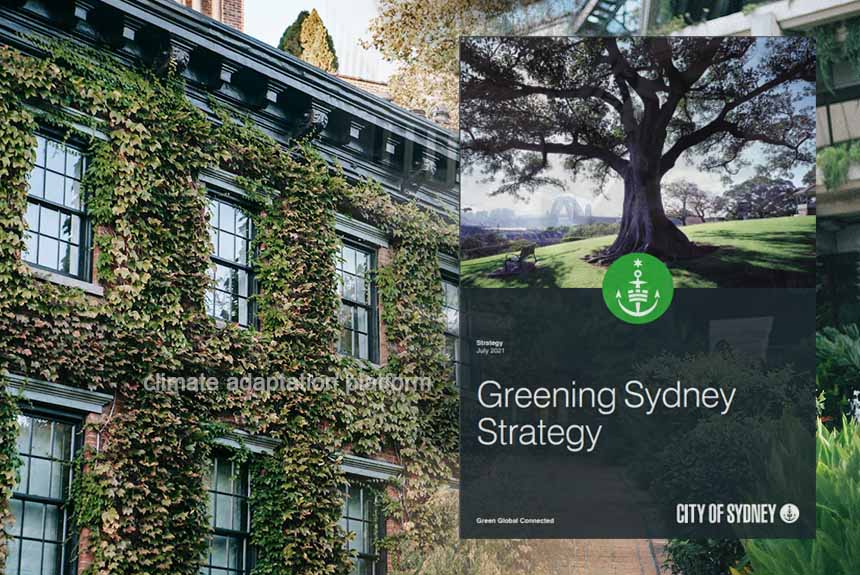As cities grow and climate change impacts worsen, governments increasingly apply green infrastructure to adapt to climate change, boosting resilience and sustainability.
A wealth of studies shows the positive impacts of green infrastructure on the urban climate and reducing the effects of urban island heat (UHI). Green infrastructure (GIs) like trees, parks, and all vegetation types provide many benefits. They offer shade to help cool the air and protect from the sun’s heat, especially during heatwaves. Integrating vegetation in the walls and roofs of buildings and structures helps to reduce the interior temperatures.
GIs also contribute to the health and well-being of residents, reducing flood risk. Integrating bioswales into stormwater infrastructure, which is increasingly applied in urban areas, reduces runoff and floods and improves urban drainage. GIs also increase water quality, air quality, and habitat area. Its other benefits are boosting social interaction and community engagement, encouraging residents to be more active, and improving their overall health.
Incentivising the cities’ uptake of blue-green infrastructure (BGI)
Robert Brears’s articles discuss the cities’ uptake of green infrastructure to combat climate change effects like rising temperatures and increased frequency and intensity of extreme natural events like storms, floods, and droughts to mitigate the urban heat island (effect), urbanisation, and pollution.
Brears’s article highlights the use of fiscal and non-fiscal tools to incentivise the implementation of blue-green infrastructure in cities. It cites the Los Angeles stormwater incentive program for the infiltration and on-site use of stormwater from industrial facilities. LA’s “Green Street” program will also see a series of vegetated infiltration swales and dry wells installed.
Another example is New York City’s incentivising BGI on private property. It provides a $43-$58 million budget to retrofit 200 “greened” acres, which will reimburse green roof projects in the city.
Non-fiscal tools use information and awareness campaigns, fast-tracking of BGI project applications by city agencies, pilot and demonstration projects, and leading by example. Brear writes that this approach produces the least resistance from stakeholders and allows policymakers to test out the programs that can become mandates later. Amsterdam uses this approach for various blue-green infrastructure in existing and new areas. Melbourne is another example when it developed the Water Smart City Model to raise awareness of the issues of stormwater quality and surface runoff.
Greening Sydney 2030 strategy
In another recent article, Brears highlights Sydney’s “Greening Sydney 2030 strategy,” an initiative to enhance the city’s ability to withstand climate challenges (Brears, 2022).

The plan sets out a series of measures to promote the use of green infrastructure, such as incorporating vegetation in laneways, roofs, and new constructions, ensuring that all parks have ample greenery, introducing the green factor score to assess and quantify the level and quality of urban greening in a project, and establishing a Greening Sydney Fund. This fund will facilitate the greening of private land through programs and grants that incentivize residents to plant new trees, install green roofs, and make other contributions to expand green spaces.
Sydney’s greening plan is also designed to mitigate the rising heat, with the goal of covering 40% of the city’s footprint with greenery by 2050. A budget of AUS$377 million (US$287 million) has been proposed for greening Sydney over the next ten years. Targets include 23% canopy cover by 2030, rising to 27% by 2050, up from 19.2% in 2020 and 15.5% in 2008 (Wray, 2021).
Rising temperatures, with the year 2024 declared the hottest on record
Climate change is increasing global temperatures, with 2023 declared by the National Oceanic and Atmospheric Administration (NOAA) as the world’s warming year and NOAA’s hottest year in its 174-year climate record.
Most recently, in September, Copernicus declared the 2024 summer to be the hottest on record globally and in Europe. EU’s climate change monitor’s observation shows that the global average temperature for the past 12 months, between September 2023 and August 2024, is the highest on record for any 12 months at 0.76°C above the 1991–2020 average and 1.64°C above the 1850–1900 pre-industrial average.
Many climate scientists expect temperatures to keep rising, and heat-related events will only worsen with more devastating consequences for people and the planet unless we curb emissions and do more climate change adaptation.
Source:
Sturiale L., & Scuderi A. (2010). The Role of Green Infrastructures in Urban Planning for Climate Change Adaptation. Climate. Retrieved from https://www.mdpi.com/2225-1154/7/10/119
Brears, R. (11 September 2024). Green Infrastructure Strategies: Boosting Urban Resilience and Climate Adaptation. Medium. Retrieved from https://medium.com/our-future-water/green-infrastructure-strategies-boosting-urban-resilience-and-climate-adaptation-4ffdd530aa4f
Brears, R. (2022, November 9). Blue and Green Cities: The Role of Blue-Green Infrastructure in Managing Urban Water Resources. Medium. Retrieved from https://medium.com/mark-and-focus/blue-and-green-cities-the-role-of-blue-green-infrastructure-in-managing-urban-water-resources-5e63ba14d35d
Wray, S. (2021, March 2021). Sydney to cover 40 percent of the city in greenery to beat heat. Cities Today. Retrieved from https://cities-today.com/sydney-to-cover-40-percent-of-the-city-in-greenery-to-beat-heat/#:~:text=The%20City%20of%20Sydney%20plans,footprint%20with%20greenery%20by%202050
Greening Sydney Strategy. (2021 July). City of Sydney. Retrieved from https://www.cityofsydney.nsw.gov.au/strategies-action-plans/greening-sydney-strategy
2023 was the world’s warmest year on record, by far. (2024, January 12). NOAA. Retrieved from https://www.noaa.gov/news/2023-was-worlds-warmest-year-on-record-by-far
Copernicus: Summer 2024 – Hottest on record globally and for Europe. (2024, September 6). Copernicus. Retrieved from https://climate.copernicus.eu/copernicus-summer-2024-hottest-record-globally-and-europe



Leave a Reply